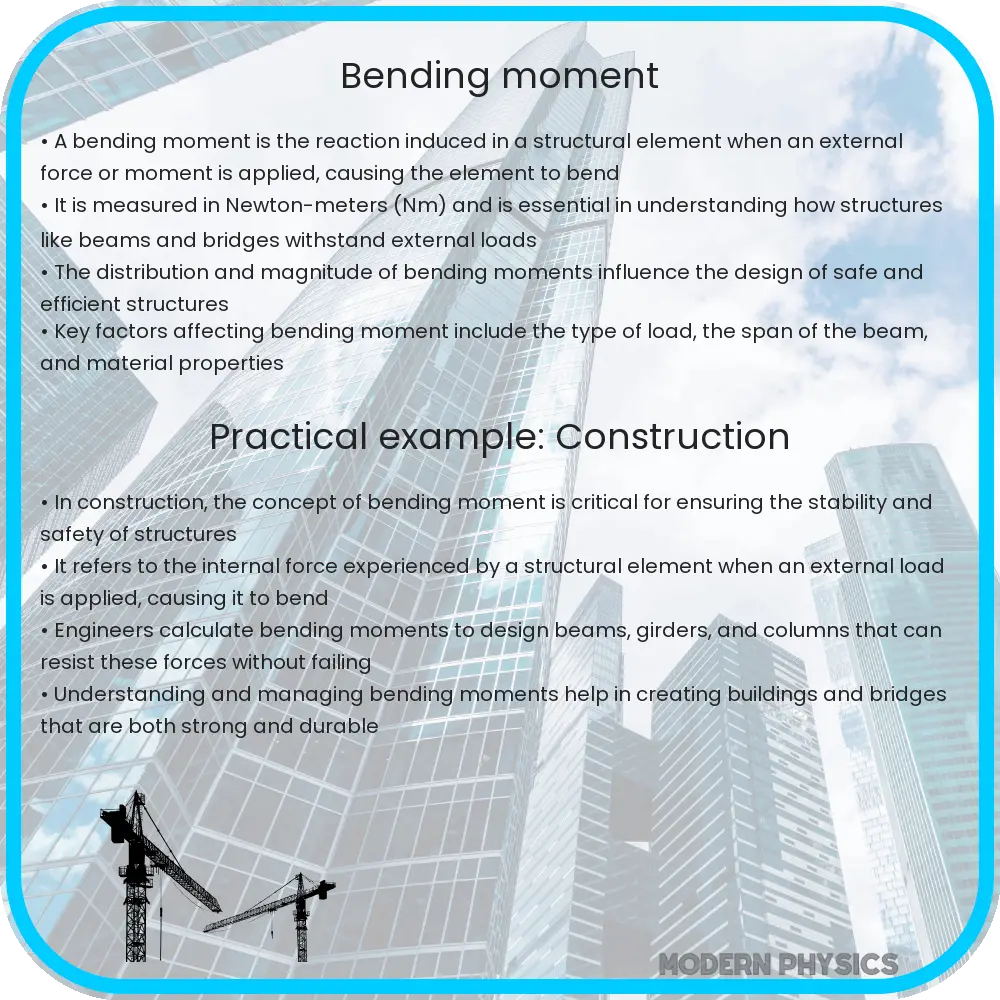Explore the fundamentals of bending moments, including their calculation, analysis, and impact on structural engineering and material selection.

Understanding Bending Moment: Concepts and Calculations
Bending moment, a fundamental concept in engineering mechanics, is essential in understanding how forces affect structures and materials. It refers to the internal moment that causes a material to bend. When a structural element, like a beam, is subjected to forces, these forces create a moment about any point along the beam, causing it to bend or flex. This article will delve into the basics of bending moments, including their calculation and analysis in structural engineering.
Definition and Principles of Bending Moment
The bending moment at a section within a structure is a measure of the bending effect due to forces acting on the structure. It is defined as the algebraic sum of the moments about the neutral axis of any cross-section of a beam. This concept is crucial in designing and analyzing beams, bridges, and other structural elements to ensure their strength and stability under various loading conditions.
Calculating Bending Moments
The calculation of bending moments is a critical step in structural analysis. It involves determining the reaction forces at supports and the moments caused by these forces. The bending moment at any point along a beam can be calculated using the following formula:
M = F x d
where M is the bending moment, F is the force, and d is the perpendicular distance from the point of interest to the line of action of the force. Engineers use this formula to calculate the bending moments at different points along a beam, enabling them to design beams that can withstand the expected loads.
Types of Bending Moments
Bending moments can be classified into two main types: positive and negative. A positive bending moment causes the bottom fibers of a beam section to stretch, while the top fibers are compressed. Conversely, a negative bending moment results in the compression of the bottom fibers and the stretching of the top fibers.
Understanding the distinction between positive and negative bending moments is crucial for determining the stress distribution within a beam and for the correct placement of reinforcement in structures like reinforced concrete beams.
Analysis of Bending Moments
Analysing bending moments involves creating bending moment diagrams, which graphically represent the variation of bending moment along the length of the beam. These diagrams are instrumental in identifying points of maximum stress and in designing beams for strength and stability.
In summary, the bending moment is a vital concept in structural engineering, providing insights into how forces and moments affect the structural integrity of beams and other elements. Correct calculation and analysis of bending moments are essential in ensuring that structures are both safe and efficient.
Impact of Bending Moments on Material Selection
The choice of materials for any structural component is heavily influenced by the bending moments it will experience. Different materials exhibit varying degrees of strength and flexibility under bending stresses. Engineers must select materials that can not only support the calculated bending moments but also offer longevity and durability. For instance, steel is preferred for its high tensile strength in scenarios where large bending moments are anticipated, while wood might be used for its flexibility in applications with lower stress levels.
Advanced Techniques in Bending Moment Analysis
With advancements in technology, the analysis of bending moments has become more sophisticated. Computational methods, like finite element analysis (FEA), allow engineers to model complex structures and accurately predict how they will respond to various loads. These methods enable the analysis of bending moments in more complex structures, such as irregularly shaped beams or structures with non-uniform loading conditions.
Practical Applications and Real-World Examples
The principles of bending moments are applied in numerous real-world scenarios. In bridge design, for instance, understanding bending moments is crucial for ensuring that the bridge can withstand the weight of traffic and environmental forces like wind or earthquakes. Similarly, in building construction, beams and columns are designed based on bending moment calculations to ensure the stability and safety of the structure.
Conclusion
In conclusion, the concept of bending moment is fundamental to the field of structural engineering. It is essential for understanding how forces and moments influence the structural integrity and design of various elements. Accurate calculation and analysis of bending moments ensure the safety, efficiency, and longevity of structures. As technology advances, the methods for analyzing bending moments continue to evolve, offering more precise and complex analysis capabilities. This continuous development underscores the importance of bending moments in engineering and their critical role in shaping the world of structural design.
Understanding and effectively applying the principles of bending moments allows engineers to create structures that are not only functional but also safe and durable, contributing significantly to the advancement of modern infrastructure and architecture.
